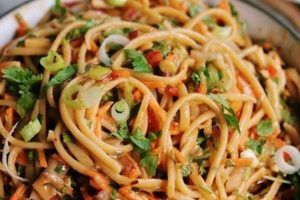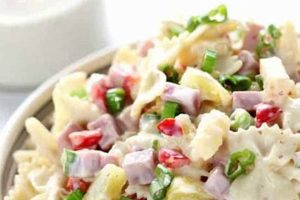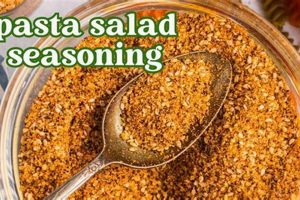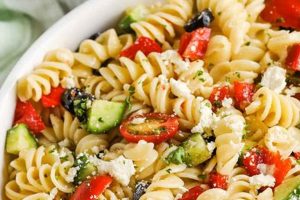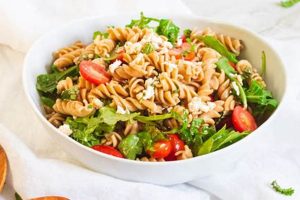A chilled dish featuring cooked pasta combined with an assortment of fresh or cooked vegetables, often bound with a vinaigrette or mayonnaise-based dressing, constitutes this culinary creation. A typical example might include rotini pasta, chopped bell peppers, cucumbers, cherry tomatoes, and a light Italian dressing.
This versatile dish offers numerous advantages. Its adaptability allows for variations in ingredients to suit individual preferences and dietary needs. The incorporation of fresh vegetables provides essential vitamins and fiber, contributing to a balanced meal. Suitable for picnics, potlucks, and light lunches, it can be prepared in advance, making it a convenient and time-saving meal option. Historically, cold pasta dishes have existed in various cultures for centuries, evolving over time to include a wider array of ingredients and flavors, reflecting regional preferences and seasonal availability.
Further exploration will delve into specific ingredient combinations, dressing variations, preparation techniques, and tips for optimal flavor and presentation. Considerations for dietary adaptations, such as gluten-free or vegan options, will also be addressed.
Tips for Creating Exceptional Pasta Salads with Vegetables
Optimizing ingredient selection, preparation methods, and flavor combinations elevates this simple dish to culinary excellence. Attention to detail ensures a vibrant, flavorful, and satisfying experience.
Tip 1: Pasta Selection: Short, sturdy pasta shapes, such as rotini, farfalle, or penne, hold their shape well and capture dressing effectively. Avoid long, thin pasta varieties, which can become tangled and clump together.
Tip 2: Vegetable Variety: Incorporate a diverse range of colorful vegetables for visual appeal and nutritional value. Consider bell peppers, cucumbers, cherry tomatoes, red onion, broccoli florets, and snap peas.
Tip 3: Blanching Techniques: Blanching certain vegetables, such as broccoli or green beans, preserves their vibrant color and crisp texture while ensuring they are tender. Quickly immerse them in boiling water, then plunge into ice water to halt the cooking process.
Tip 4: Dressing Considerations: A light, flavorful dressing complements the vegetables and pasta without overpowering them. Vinaigrettes, lemon-herb dressings, or creamy dressings based on yogurt or light mayonnaise offer suitable options.
Tip 5: Flavor Enhancement: Fresh herbs, such as basil, parsley, or dill, add brightness and depth of flavor. Incorporate them just before serving to maximize their aroma and impact.
Tip 6: Proper Chilling: Allow the salad to chill thoroughly in the refrigerator for at least 30 minutes before serving. This allows the flavors to meld and enhances the overall experience.
Tip 7: Ingredient Proportion: Strive for a balanced ratio of pasta to vegetables. Overloading the salad with pasta can result in a bland, less satisfying dish.
By following these guidelines, one can achieve a pasta salad with vegetables that is not only visually appealing and nutritious but also bursting with fresh, vibrant flavors.
In conclusion, the combination of thoughtful ingredient selection, appropriate cooking techniques, and balanced flavor profiles ensures a successful and enjoyable culinary creation.
1. Pasta Choice
Pasta selection significantly influences the overall success of a pasta salad with vegetables. The shape, size, and texture of the pasta affect how well it absorbs the dressing, interacts with the other ingredients, and contributes to the final presentation. Appropriate pasta choices enhance the dish’s flavor, texture, and visual appeal.
- Shape and Structure:
Short, sturdy pasta shapes, such as rotini, fusilli, farfalle, or penne, are generally preferred for pasta salad. Their complex shapes and ridges effectively capture and hold the dressing, ensuring even distribution of flavor. These shapes also maintain their structure well, preventing the salad from becoming mushy or clumping together. Conversely, long, thin pasta varieties like spaghetti or linguine are less suitable as they tend to tangle, making the salad difficult to serve and eat.
- Size and Texture:
Bite-sized pasta pieces are ideal for pasta salad, allowing for easy consumption and ensuring a pleasant mouthfeel. The pasta’s texture should complement the vegetables; a slightly firm, al dente texture provides a satisfying contrast to the crispness of fresh vegetables. Overcooked pasta becomes soft and mushy, detracting from the overall texture and potentially absorbing too much dressing.
- Gluten-Free Options:
Dietary considerations often necessitate alternative pasta choices. Gluten-free pasta made from rice, quinoa, or corn can successfully replace traditional wheat-based pasta. However, these varieties may have different cooking times and textures, so careful attention to package instructions and adjustments to cooking methods are crucial for optimal results.
- Flavor Pairing:
While most pasta varieties have a neutral flavor that allows the other ingredients to shine, some specialty pastas, such as spinach or tomato-flavored pasta, can add subtle nuances to the dish. These flavored options can complement specific vegetable combinations and enhance the overall taste profile of the salad.
Ultimately, the ideal pasta choice for a pasta salad with vegetables depends on the desired texture, flavor profile, and dietary needs. Careful consideration of these factors contributes to a well-balanced and enjoyable culinary experience. Selecting a pasta that harmonizes with the other ingredients creates a cohesive and flavorful dish.
2. Vegetable Selection
Vegetable selection plays a crucial role in determining the flavor, texture, nutritional value, and visual appeal of a pasta salad. The choice of vegetables significantly impacts the overall balance and complexity of the dish. Careful consideration of vegetable variety, color, texture, and seasonality ensures a well-rounded and satisfying culinary experience. For example, incorporating a mix of crunchy vegetables like bell peppers and cucumbers with softer vegetables like cherry tomatoes and cooked corn creates a textural contrast that enhances enjoyment. Choosing vegetables of varying colors, such as bright red tomatoes, deep green spinach, and vibrant orange carrots, not only adds visual interest but also provides a broader range of nutrients. Seasonal vegetables, when available, offer optimal flavor and freshness.
The interplay between raw and cooked vegetables further contributes to the complexity of a pasta salad. Raw vegetables, such as cucumbers, bell peppers, and red onion, offer crispness and a refreshing bite. Blanched or roasted vegetables, like broccoli, green beans, or asparagus, provide a tender texture and subtly different flavor profile. This combination of textures and flavors creates a dynamic and engaging culinary experience. Furthermore, the choice of vegetables can influence the choice of dressing. A light vinaigrette complements delicate vegetables like spinach and cherry tomatoes, while a creamy dressing pairs well with heartier vegetables like roasted peppers and grilled zucchini. Balancing the flavors and textures of the vegetables with the dressing creates a harmonious and well-integrated dish.
In summary, thoughtful vegetable selection elevates a pasta salad from a simple side dish to a vibrant and flavorful main course. Prioritizing variety, color, texture, and seasonality ensures a nutritionally balanced and visually appealing meal. Strategic incorporation of both raw and cooked vegetables, coupled with a complementary dressing, contributes to a complex and satisfying culinary creation. Understanding the impact of vegetable choices empowers one to craft a pasta salad tailored to individual preferences and dietary needs.
3. Dressing
Dressing serves as a unifying element in a pasta salad with vegetables, binding the individual components into a cohesive whole. The choice of dressing significantly influences the overall flavor profile, texture, and enjoyment of the dish. Careful consideration of the dressing’s ingredients, acidity, and consistency ensures a harmonious balance with the chosen vegetables and pasta.
- Flavor Profile
The dressing’s flavor profile should complement the chosen vegetables and pasta, enhancing their inherent tastes without overpowering them. Light and bright dressings, such as vinaigrettes with lemon juice, herbs, and olive oil, pair well with delicate vegetables like spinach and cherry tomatoes. Creamier dressings based on yogurt, mayonnaise, or buttermilk complement heartier vegetables like roasted peppers and grilled zucchini. The balance of sweet, sour, salty, and savory elements within the dressing contributes to the overall complexity and enjoyment of the salad. For instance, a tangy Dijon vinaigrette enhances the sweetness of roasted carrots, while a creamy dill dressing balances the earthiness of mushrooms.
- Acidity
Acidity plays a critical role in balancing the flavors of a pasta salad. A touch of acidity brightens the other flavors and provides a refreshing counterpoint to the richness of the pasta and vegetables. Vinegar, lemon juice, or citrus zest are common sources of acidity in pasta salad dressings. The level of acidity should be carefully calibrated to complement the other ingredients. Too much acidity can overpower the delicate flavors, while too little can result in a bland or uninspired dish. A properly balanced acidity enhances the overall flavor profile and adds a refreshing zing to the salad.
- Consistency and Coating Ability
The consistency of the dressing affects how well it coats the pasta and vegetables. A dressing that is too thin may not adhere properly, resulting in uneven flavor distribution and a watery salad. A dressing that is too thick may overwhelm the other ingredients and create a heavy, less enjoyable texture. The ideal consistency allows the dressing to cling lightly to the pasta and vegetables, ensuring that each bite is infused with flavor. Emulsified dressings, where the oil and vinegar are combined into a stable mixture, provide good coating ability and prevent separation.
- Ingredient Compatibility
The ingredients in the dressing should harmonize with the chosen vegetables and pasta. Fresh herbs, spices, and aromatics can add depth and complexity to the dressing’s flavor profile. Consider the flavors of the chosen vegetables and pasta when selecting herbs and spices for the dressing. For example, basil complements tomatoes, while dill pairs well with cucumbers. Garlic, shallots, and red pepper flakes can add pungent notes to the dressing, while a touch of sweetness from honey or maple syrup can balance the acidity. Careful selection of ingredients ensures a well-integrated and balanced flavor profile.
In conclusion, the dressing is a vital component of a successful pasta salad with vegetables. Its flavor profile, acidity, consistency, and ingredient compatibility all contribute to the overall harmony and enjoyment of the dish. Thoughtful selection and preparation of the dressing elevates the pasta salad from a simple side to a complex and satisfying culinary creation. By carefully considering these elements, one can craft a dressing that perfectly complements the chosen vegetables and pasta, resulting in a delicious and well-balanced salad.
4. Flavor Balancing
Flavor balancing constitutes a crucial aspect of crafting a successful pasta salad with vegetables. A harmonious blend of flavors elevates the dish beyond a simple combination of ingredients, creating a complex and satisfying culinary experience. Balancing contrasting tastessweet, sour, salty, bitter, and umamiensures no single flavor dominates, resulting in a well-rounded and enjoyable palate sensation. This balance prevents the salad from tasting overly sweet, excessively tart, or bland. For instance, the sweetness of roasted red peppers can be balanced by the tanginess of a vinaigrette, while the saltiness of feta cheese complements the bitterness of Kalamata olives.
The interplay of textures further enhances flavor perception. Crunchy vegetables, such as celery or raw bell peppers, contrast with softer elements like cooked pasta and cherry tomatoes. This textural variation creates a dynamic mouthfeel that complements the balanced flavor profile. Additionally, incorporating fresh herbs, such as basil, mint, or parsley, introduces aromatic complexity, further elevating the sensory experience. These herbs not only contribute their own unique flavors but also enhance the existing flavors of the vegetables and dressing. Furthermore, the temperature of the salad impacts flavor perception; a chilled pasta salad allows the flavors to meld and intensify, creating a more refreshing and enjoyable experience.
Achieving flavor balance requires careful consideration of ingredient selection and preparation. Understanding the inherent flavors of each vegetable allows for strategic combinations that complement and contrast one another. For example, pairing bitter greens with sweet fruits or salty cheeses creates a balanced flavor profile. The dressing also plays a critical role in balancing the flavors of the salad. A vinaigrette with the right balance of acidity and sweetness can tie all the ingredients together, creating a cohesive and flavorful dish. Overall, flavor balancing transforms a pasta salad with vegetables into a sophisticated and enjoyable culinary creation, highlighting the importance of thoughtful ingredient selection and preparation.
5. Preparation Method
Preparation method significantly influences the final outcome of a pasta salad with vegetables. Proper techniques ensure optimal texture, flavor, and food safety. Each step, from cooking the pasta to combining ingredients, contributes to the overall quality and enjoyment of the dish. For instance, cooking pasta al dente prevents a mushy texture, while proper vegetable handling maintains crispness and vibrancy. Neglecting these steps can result in a subpar salad with compromised flavor and texture.
The order of operations within the preparation method also plays a crucial role. Adding the dressing too early can lead to soggy vegetables and over-saturated pasta. Incorporating delicate herbs at the beginning of the process diminishes their flavor and aroma. Conversely, adding them just before serving preserves their freshness and impact. Blanching certain vegetables, like green beans or broccoli, preserves their color and texture while reducing cooking time in the final salad. Cooling the pasta thoroughly before combining it with other ingredients prevents the dressing from separating and ensures food safety.
Understanding the nuances of preparation methods empowers one to create a superior pasta salad with vegetables. Attention to detail, from ingredient preparation to final assembly, results in a dish that is not only visually appealing but also delivers optimal flavor and texture. Consistent application of these techniques ensures a consistently high-quality culinary experience. Mastering these techniques allows for greater creativity and customization, enabling individuals to tailor their pasta salads to specific preferences and dietary needs.
Frequently Asked Questions
This section addresses common inquiries regarding the creation and enjoyment of pasta salad incorporating vegetables. Clarity on these points facilitates successful preparation and enhances overall culinary satisfaction.
Question 1: What is the best way to prevent pasta salad from becoming soggy?
Sogginess can be prevented by ensuring the pasta is cooked al dente, thoroughly drained, and cooled before combining it with other ingredients. Adding the dressing just before serving further minimizes moisture absorption. Choosing sturdy pasta shapes also helps maintain texture.
Question 2: How long can pasta salad be stored in the refrigerator?
Properly stored in an airtight container, pasta salad typically remains fresh for three to five days in the refrigerator. However, salads containing mayonnaise-based dressings may have a shorter shelf life. Always assess the salad’s quality before consumption.
Question 3: Can frozen vegetables be used in pasta salad?
While fresh vegetables are generally preferred for optimal texture and flavor, frozen vegetables can be used in pasta salad. Thaw and thoroughly drain them before incorporating them to prevent excess moisture. Certain frozen vegetables, such as peas or corn, may benefit from a brief blanching to enhance their texture and color.
Question 4: What are some suitable protein additions for a more substantial pasta salad?
Grilled chicken, shrimp, chickpeas, white beans, or cubed tofu can enhance the protein content of pasta salad. These additions contribute to a more balanced and satisfying meal. Ensure protein elements are cooked and cooled thoroughly before adding them to the salad.
Question 5: How can one adapt pasta salad recipes for specific dietary needs, such as gluten-free or vegan?
Gluten-free pasta can be substituted for traditional pasta to accommodate gluten-free diets. Vegan options can utilize plant-based mayonnaise or create dressings based on olive oil and vinegar. Ensure all ingredients align with the specific dietary restrictions.
Question 6: Can pasta salad be frozen?
Freezing pasta salad is generally not recommended. Freezing alters the texture of the vegetables and pasta, resulting in a less desirable consistency upon thawing. The dressing may also separate, compromising the overall quality of the salad.
Understanding these frequently asked questions helps ensure successful preparation and maximizes enjoyment of pasta salad with vegetables.
Further resources and recipe variations can be explored in the following sections.
Pasta Salad with Veggies Recipe
Exploration of this culinary concept reveals its adaptability and potential for creative expression. Careful selection of pasta shape, vegetable variety, and dressing composition contributes to a balanced and flavorful outcome. Proper preparation techniques, including cooking pasta al dente, blanching vegetables, and chilling the salad thoroughly, ensure optimal texture and food safety. Addressing common inquiries regarding ingredient selection, storage, and dietary adaptations further empowers culinary experimentation.
The versatility inherent within this dish allows for endless variations, limited only by culinary imagination. Continued exploration of flavor profiles, textures, and ingredient combinations promises an evolving culinary landscape, enriching gastronomic experiences and fostering creative culinary endeavors.

